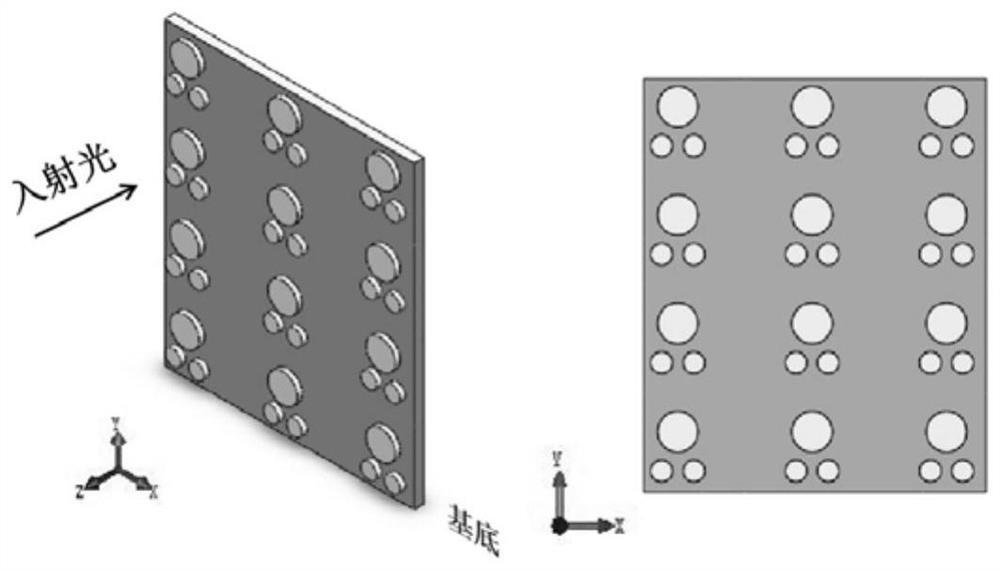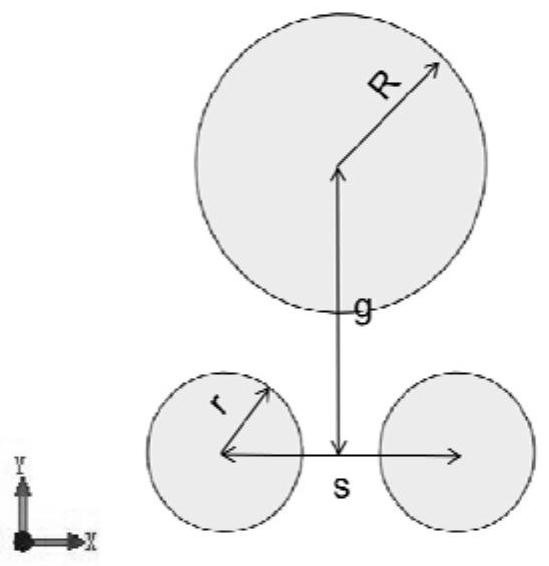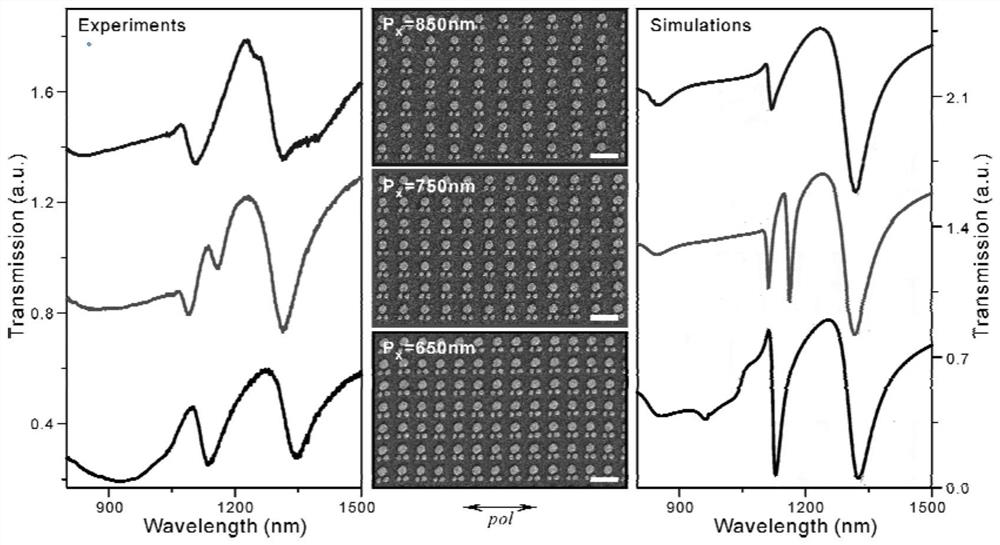A structure producing multiple surface lattice resonances and its application
A lattice and multiple technology, applied in the field of micro-nano photonic devices, can solve the problem of not being able to suppress the radiation loss of the system at the same time in multiple bands, and achieve the effect of suppressing the radiation loss of the system
- Summary
- Abstract
- Description
- Claims
- Application Information
AI Technical Summary
Problems solved by technology
Method used
Image
Examples
Embodiment 1
[0025] A structure generating multiple surface lattice resonances from a gold nanodisk trimer C 2V Molecules are arranged in an orderly array structure, such as figure 2 As shown, gold nanodisk trimer C 2V The molecule is composed of three gold nanodisks with the same thickness and different diameters. Among them, the diameters of the two small gold nanodisks are equal, the radius of the small gold nanodisk is r=80nm, the radius of the large gold nanodisk is R=150nm, s=240nm, g= 290nm, the thickness of both large and small gold nanodisks is h=50nm; figure 1 As shown, the above-mentioned array structure is etched on a quartz-PMMA (polymethyl methacrylate) substrate by ion / electron etching method, and a multi-mode surface plasmon laser chip is produced.
[0026] In order to test the performance of the above-mentioned plasmonic laser chip, through the electron beam etching experiment, the prepared sample was immersed in the oil matching the set refractive index for measurement...
Embodiment 2
[0028] A structure generating multiple surface lattice resonances from gold nanodisk tetramer C 2V Molecules are arranged in an orderly array structure, such as Figure 5 As shown, gold nanodisk tetramer C 2V The molecule is composed of four gold nanodisks, in which two small gold nanodisks have a radius of r=70nm, and two large gold nanodisks have a radius of R=90nm, s 1 =170nm,s 2 =240nm,s 3 =240nm, the thickness of the large and small gold nanodisks is h=50nm; if Figure 4 As shown, the above array structure is etched on the quartz-PMMA substrate by ion / electron etching method to make a multi-mode surface plasmon laser chip;
[0029] like Figure 6 As shown, electron beam etching experiments show that when the polarization direction of the incident field is in the x direction, the period P in the direction perpendicular to the polarization direction of the incident field is maintained y is 750nm, changing the period P in the polarization direction parallel to the inc...
Embodiment 3
[0031] A structure generating multiple surface lattice resonances from a gold nanodisk trimer D 3h Molecules are arranged in an orderly array structure, trimer D 3h The molecular point group is composed of three gold nanodisks of the same size. The radius of the gold nanodisk is set to r=80nm, the distance between the center of the gold nanodisk is s=175nm, and the thickness of the gold nanodisk is h=50nm. The above array structure is etched by ion / electron method etched on a quartz-PMMA substrate, such as Figure 7 As shown, the multi-mode surface plasmon laser chip is manufactured, the effect is the same as that of embodiment 1, and multiple surface lattice resonance can also be realized.
PUM
| Property | Measurement | Unit |
|---|---|---|
| radius | aaaaa | aaaaa |
| thickness | aaaaa | aaaaa |
| radius | aaaaa | aaaaa |
Abstract
Description
Claims
Application Information
 Login to View More
Login to View More - R&D
- Intellectual Property
- Life Sciences
- Materials
- Tech Scout
- Unparalleled Data Quality
- Higher Quality Content
- 60% Fewer Hallucinations
Browse by: Latest US Patents, China's latest patents, Technical Efficacy Thesaurus, Application Domain, Technology Topic, Popular Technical Reports.
© 2025 PatSnap. All rights reserved.Legal|Privacy policy|Modern Slavery Act Transparency Statement|Sitemap|About US| Contact US: help@patsnap.com



